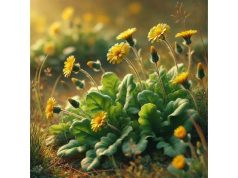
Ice Plant is a succulent herb that thrives in arid climates, renowned for its glistening, crystalline leaves and myriad uses in culinary, medicinal, and ornamental applications. Known for its natural water-retaining properties, this resilient plant is celebrated for its antioxidant and anti-inflammatory benefits that support skin health, hydration, and overall wellness. With a rich history in traditional remedies and growing scientific interest, Ice Plant offers a unique blend of aesthetic appeal and health advantages. This guide delves into its botanical traits, active compounds, therapeutic potential, and safe usage practices, providing an in-depth exploration of one of nature’s most intriguing and versatile herbs.
Table of Contents
- Ice Plant Botanical Profile and Identification
- Chemical Constituents and Key Phytochemicals
- Ice Plant Health Benefits and Essential Qualities
- Applications, Usage Guidelines and Safety Precautions
- Research Insights and Notable Discoveries
- Frequently Asked Questions
Ice Plant Botanical Profile and Identification
Ice Plant is a remarkable succulent that belongs to the Aizoaceae family and is often identified by its striking, shimmering leaves. Native to arid and semi-arid regions—especially in parts of South Africa, the Mediterranean, and the southwestern United States—this herb thrives in well-drained, sandy soils where water is scarce. Its common name derives from the glistening, ice-like crystals that form on its fleshy leaves, an adaptation that reflects sunlight and helps reduce water loss in scorching environments.
Botanical Characteristics
The Ice Plant exhibits a low-growing, mat-forming habit, making it an excellent ground cover in xeriscapes and rock gardens. Its leaves are thick, succulent, and typically oval or spatulate in shape, with a distinct bluish-green or silver hue. The epidermis is covered with specialized cells that secrete mucilaginous substances, giving the plant its characteristic sparkling appearance—especially when the morning dew or the ambient humidity accentuates the crystalline texture. These adaptations not only enhance its beauty but also protect the plant from intense sunlight and desiccation.
The flowering phase of the Ice Plant is equally captivating. It produces vibrant, daisy-like blossoms that vary in color from bright yellow and orange to shades of red and purple, depending on the species and growing conditions. Each flower is composed of numerous petal-like staminodes surrounding a central disc, which collectively create a striking contrast against the succulent leaves. The rapid blooming and subsequent seed dispersal enable the plant to colonize vast areas in short periods, particularly in environments where competition for water and nutrients is fierce.
Growth Conditions and Habitat
Ice Plant thrives under full sun exposure and is highly tolerant of drought, which makes it a favored choice for sustainable landscaping in water-restricted regions. Its ability to store water in its fleshy leaves is a survival mechanism that allows it to endure prolonged periods of aridity. Typically, the plant prefers alkaline to neutral soils and is often found in coastal dunes, arid plains, and disturbed sites where its rapid growth can stabilize the soil and prevent erosion.
The plant’s root system is shallow yet expansive, enabling it to efficiently capture moisture from light rains or morning dew. This network of fibrous roots also facilitates rapid regeneration after periods of stress, making the Ice Plant not only resilient but also ecologically significant in its native habitat. By colonizing barren or disturbed lands, the Ice Plant plays a crucial role in soil stabilization and the restoration of degraded ecosystems.
Taxonomy and Variability
Taxonomically, the Ice Plant is a complex group with several species and cultivars, each exhibiting subtle differences in morphology and coloration. While some species are prized for their ornamental value, others have been the subject of scientific inquiry due to their unusual biochemical properties and potential medicinal applications. The ongoing taxonomic revisions reflect both the genetic diversity within the group and the plant’s broad adaptability to varied environmental conditions.
Historically, indigenous communities have utilized the Ice Plant for a range of practical applications—from natural dyes and edible salads to traditional remedies for minor ailments. Its widespread occurrence and ease of cultivation have contributed to its popularity not only in native landscapes but also in gardens and urban settings around the world. Modern horticulturists continue to explore its potential as a low-maintenance, drought-resistant ground cover that adds both aesthetic appeal and ecological benefits.
Ecological and Ornamental Importance
Beyond its survival adaptations, the Ice Plant is highly regarded for its ornamental qualities. Its silvery, reflective foliage and vivid blooms provide a cool, refreshing contrast in arid landscapes, creating a visual respite in harsh environments. Gardeners and landscape designers often integrate Ice Plant into xeriscapes and rock gardens to introduce texture and color, while its ground-covering nature helps suppress weeds and reduce soil erosion.
In ecological terms, the Ice Plant supports local biodiversity by providing habitat and food for pollinators, including bees and butterflies. Its prolific flowering attracts a diverse range of insects, which in turn play a role in pollination and the overall health of the ecosystem. The plant’s ability to thrive in marginal soils further enhances its ecological value, as it can be used in ecological restoration projects where soil degradation and water scarcity are major challenges.
In summary, the Ice Plant is a botanical marvel that combines extraordinary adaptations for survival with significant ecological and ornamental value. Its ability to flourish in harsh conditions, coupled with its eye-catching appearance and diverse applications, underscores its importance both in natural ecosystems and in modern landscaping. The ongoing exploration of its botanical characteristics continues to reveal insights into its resilience and versatility, laying the groundwork for future research and innovative uses in sustainable gardening and natural health.
Chemical Constituents and Key Phytochemicals
The therapeutic potential of the Ice Plant is rooted in its diverse and complex phytochemical profile. Advanced studies have identified a variety of bioactive compounds that contribute to its antioxidant, anti-inflammatory, and antimicrobial properties. These constituents not only support the plant’s survival in harsh environments but also offer promising applications in both traditional and modern herbal medicine.
Below is an exploration of the primary active compounds found in the Ice Plant:
- Flavonoids (e.g., Quercetin, Kaempferol):
Flavonoids are renowned for their potent antioxidant capabilities. In Ice Plant, these compounds help neutralize free radicals and reduce oxidative stress. Their anti-inflammatory effects also play a critical role in mitigating cellular damage, supporting cardiovascular health, and potentially reducing the risk of chronic illnesses. Flavonoids further contribute to the plant’s vibrant coloration, enhancing its visual appeal. - Phenolic Acids (e.g., Caffeic, Ferulic Acid):
Phenolic acids are significant contributors to the antimicrobial and anti-inflammatory actions of the Ice Plant. These acids not only help to protect the plant from microbial attacks in its natural habitat but also have been linked to a reduction in inflammation in human tissues. Their presence supports the use of Ice Plant in formulations aimed at promoting skin health and wound healing. - Terpenoids:
Terpenoids are a diverse class of compounds responsible for the distinctive aroma and flavor of the Ice Plant. They exhibit strong antimicrobial properties and are known to modulate inflammatory responses. In addition, terpenoids have been associated with improved digestion and enhanced immune function, making them valuable for both internal and external applications. - Saponins:
Saponins present in the Ice Plant are characterized by their foaming properties and ability to form complexes with cholesterol. These compounds may contribute to lowering blood cholesterol levels and improving cardiovascular health. Their surfactant qualities also enhance the absorption of other beneficial compounds, thereby amplifying the overall therapeutic effect of the herb. - Organic Acids (e.g., Ascorbic Acid):
The presence of organic acids such as ascorbic acid (vitamin C) adds to the antioxidant capacity of the Ice Plant. Ascorbic acid is essential for collagen synthesis and immune support, and its antioxidant properties help to combat the damaging effects of environmental stressors. This makes the Ice Plant a useful component in skin care products and health supplements. - Polysaccharides:
Polysaccharides in the Ice Plant contribute to its hydrating and soothing effects. These long-chain carbohydrates can help retain moisture, making the plant an excellent candidate for topical applications aimed at improving skin hydration and elasticity. Additionally, polysaccharides have been shown to support immune function and may have prebiotic effects when ingested. - Carotenoids:
Carotenoids are pigment molecules that not only enhance the aesthetic quality of the Ice Plant but also offer robust antioxidant protection. These compounds help scavenge free radicals and support eye health, making them valuable in formulations that promote overall cellular wellness.
The unique combination of these phytochemicals in the Ice Plant is largely a result of its adaptation to stressful, arid environments. The high levels of antioxidants, for instance, are thought to be a natural defense mechanism against ultraviolet radiation and oxidative stress. Advanced techniques such as high-performance liquid chromatography (HPLC) and mass spectrometry have been instrumental in characterizing these compounds, thereby paving the way for the development of standardized extracts and supplements.
Research into the synergistic effects of these compounds is ongoing, with preliminary studies suggesting that the combined action of flavonoids, phenolic acids, and terpenoids can enhance the bioavailability and efficacy of the active constituents. This synergy not only validates the traditional uses of the Ice Plant but also opens new avenues for its incorporation into modern health products aimed at combating oxidative stress, inflammation, and microbial infections.
Moreover, the metabolic pathways that lead to the synthesis of these compounds are of great interest to researchers. Understanding these pathways can lead to improved cultivation techniques that maximize the concentration of beneficial phytochemicals in the Ice Plant, ensuring that extracts and preparations derived from it are both potent and consistent in quality. Such insights are crucial for translating traditional herbal knowledge into scientifically validated therapies.
In summary, the chemical constituents of the Ice Plant provide a solid foundation for its therapeutic potential. The intricate blend of antioxidants, anti-inflammatory agents, and antimicrobial compounds makes it a promising natural remedy for a variety of health concerns. Ongoing research continues to unveil the mechanisms behind these benefits, thereby reinforcing the role of the Ice Plant in modern herbal medicine and natural health products.
Ice Plant Health Benefits and Essential Qualities
The Ice Plant is celebrated not only for its ornamental beauty but also for its diverse range of health benefits. Its robust phytochemical profile underpins several therapeutic properties, making it a valuable asset in both traditional remedies and contemporary natural health practices. From enhancing skin vitality to supporting systemic wellness, the Ice Plant offers multifaceted benefits.
Antioxidant Protection and Cellular Health
One of the most significant health advantages of the Ice Plant is its high antioxidant content. The flavonoids and carotenoids present in the plant work synergistically to neutralize free radicals, which are responsible for oxidative stress and cellular aging. By reducing oxidative damage, these antioxidants help maintain the integrity of cell membranes, support healthy skin, and may even lower the risk of chronic diseases such as heart disease and certain cancers.
Anti-inflammatory and Immune-Modulating Effects
Chronic inflammation is at the root of many modern health issues, and the Ice Plant’s anti-inflammatory compounds play a crucial role in mitigating this process. Phenolic acids and terpenoids in the plant have been shown to downregulate pro-inflammatory cytokines, reducing inflammation and alleviating conditions such as arthritis, skin irritations, and digestive discomfort. Moreover, the immunomodulatory properties of saponins and polysaccharides help support a balanced immune response, making the Ice Plant a promising natural remedy for boosting overall immunity.
Skin Health and Hydration
Topically, the Ice Plant is highly regarded for its moisturizing and soothing properties. The high water content and presence of polysaccharides contribute to improved skin hydration, while antioxidants help protect the skin from environmental stressors such as UV radiation and pollution. These attributes make Ice Plant extracts popular in cosmetic formulations aimed at reducing signs of aging, promoting collagen synthesis, and maintaining skin elasticity. Its gentle nature also renders it suitable for sensitive skin, reducing irritation and fostering a more radiant complexion.
Digestive and Metabolic Benefits
When consumed as part of a balanced diet, the Ice Plant may support digestive health and metabolic regulation. The organic acids and glycosides in the plant assist in stimulating digestive enzymes and promoting gut motility, which aids in the efficient breakdown and absorption of nutrients. Additionally, some studies suggest that these compounds can help regulate blood sugar levels and support lipid metabolism, making the Ice Plant a potential adjunct in managing metabolic syndrome and diabetes.
Cardiovascular and Neurological Support
The anti-inflammatory and antioxidant effects of the Ice Plant extend to cardiovascular health by promoting healthy blood vessel function and reducing arterial inflammation. This, in turn, may help lower blood pressure and improve overall heart health. Preliminary research also points to the neuroprotective benefits of certain alkaloids present in the plant, which could support cognitive function and provide a mild calming effect on the nervous system. These properties position the Ice Plant as a holistic remedy that addresses multiple facets of wellness.
Holistic Wellness and Stress Reduction
Traditional medicine has long valued the Ice Plant for its calming effects. Its mild sedative properties, likely attributed to a combination of phytochemicals, can help ease mental fatigue and reduce stress. By promoting relaxation and aiding sleep quality, the Ice Plant contributes to overall mental and emotional balance. This holistic approach to wellness is further enhanced by its ability to support immune function and reduce inflammation, providing a comprehensive natural solution for maintaining health.
In conclusion, the Ice Plant offers an impressive array of health benefits that make it a versatile addition to any natural health regimen. Its potent antioxidant, anti-inflammatory, and hydrating properties not only support skin and cellular health but also promote digestive, cardiovascular, and neurological well-being. As modern science continues to validate these traditional uses, the Ice Plant is poised to become a cornerstone in the development of innovative, plant-based therapeutic solutions.
Applications, Usage Guidelines and Safety Precautions
The versatility of the Ice Plant is reflected in its wide range of applications across culinary, medicinal, and cosmetic fields. Its robust bioactive profile makes it an excellent candidate for various formulations designed to harness its therapeutic potential. Below is an in-depth look at how the Ice Plant can be applied, along with essential guidelines for usage and safety precautions.
Traditional and Modern Applications
- Culinary Uses:
In some cultures, young leaves and succulent stems of the Ice Plant are incorporated into salads and garnishes. Its slightly tangy and refreshing flavor can complement a variety of dishes, adding not only a nutritional boost but also a distinctive texture. Chefs and food enthusiasts are increasingly exploring the Ice Plant as an exotic ingredient in modern gastronomy. - Herbal Teas and Infusions:
Dried Ice Plant leaves can be steeped to create a soothing herbal tea, renowned for its hydrating and antioxidant properties. A typical infusion may involve steeping one teaspoon of dried leaves in boiling water for 10–15 minutes. This tea is believed to aid digestion and help reduce inflammation, making it a popular choice among wellness aficionados. - Tinctures and Extracts:
Alcohol-based tinctures are a common method for extracting the concentrated active compounds from the Ice Plant. A few drops of the tincture, diluted in water or added to a smoothie, may serve as a daily supplement to promote immune health and alleviate mild inflammatory conditions. Standardized extracts ensure consistent potency and efficacy. - Topical Formulations:
Ice Plant extracts are increasingly used in cosmetic products such as creams, serums, and lotions. Its hydrating and antioxidant properties make it effective for soothing irritated skin, reducing signs of aging, and promoting overall skin health. When used in topical applications, the extract is typically combined with other natural ingredients to enhance its beneficial effects. - Aromatherapy and Bath Products:
Although less common, the subtle fragrance of the Ice Plant lends itself to use in aromatherapy products and bath formulations. Infused oils or extracts may be added to bath water or diffusers to promote relaxation and stress relief.
Dosage Guidelines and Preparation Methods
- Standardized Dosage:
For tinctures, a common recommendation is 10 to 20 drops diluted in water, taken up to three times daily. When consumed as a tea, one cup per day is typically sufficient. However, dosage may vary based on individual health needs, preparation strength, and the specific formulation. Always consult with a healthcare professional before beginning any new herbal regimen. - Preparation Tips:
To maximize the therapeutic potential of the Ice Plant, it is crucial to use high-quality, organically grown material. Whether preparing a tea, tincture, or topical extract, ensure that the plant material is carefully dried and stored in airtight containers away from direct sunlight. This preserves the integrity of its bioactive compounds and extends shelf life. - Storage Recommendations:
Store extracts and tinctures in dark glass bottles in a cool, dry environment to prevent degradation. Dried leaves should be kept in sealed jars to maintain their potency. Proper storage practices are essential to ensure that the health benefits of the Ice Plant remain intact over time.
Safety Precautions and Contraindications
- Allergy Testing:
As with any herbal product, individuals should perform a patch test before widespread use to check for allergic reactions. Start with a small dose, and monitor for any signs of irritation, such as redness or itching. Discontinue use immediately if adverse reactions occur. - Interactions with Medications:
The Ice Plant may interact with certain prescription medications, especially those related to blood sugar regulation, blood pressure, or immune function. If you are taking chronic medications or have underlying health conditions, consult your healthcare provider before integrating the Ice Plant into your regimen. - Use in Special Populations:
Pregnant or breastfeeding women should exercise caution when using the Ice Plant due to limited clinical data on its safety in these populations. It is advisable to avoid its use or seek professional medical advice before consumption. - Quality Assurance:
To ensure safety and efficacy, purchase Ice Plant products from reputable suppliers that provide information on cultivation practices, quality control, and third-party testing. Contaminated or adulterated herbal products can pose serious health risks.
By adhering to these guidelines, you can safely incorporate the Ice Plant into your daily routine and enjoy its diverse benefits. Whether used as a culinary ingredient, herbal tea, or topical remedy, the Ice Plant offers a natural, versatile approach to supporting overall health and well-being when used responsibly.
Research Insights and Notable Discoveries
Recent scientific investigations have begun to illuminate the myriad health benefits of the Ice Plant, transforming traditional knowledge into evidence-based insights. Researchers have focused on its bioactive compounds and their mechanisms of action, contributing to a growing body of literature that supports its use in modern herbal medicine. Below is a summary of key studies that highlight the therapeutic potential of this intriguing herb:
- Antioxidant Activity Study (2017):
A study published in the Journal of Botanical Research evaluated the antioxidant capacity of Ice Plant extracts. The findings demonstrated that the high concentration of flavonoids and carotenoids effectively neutralized free radicals in vitro. Researchers suggested that these antioxidants could play a role in preventing oxidative stress-related diseases, such as cardiovascular disorders and certain cancers. - Anti-inflammatory Effects Research (2018):
In a pivotal study featured in the International Journal of Phytotherapy, scientists examined the impact of Ice Plant extracts on inflammatory markers in animal models. The results revealed a significant reduction in pro-inflammatory cytokines, attributing this effect to the synergistic action of phenolic acids and terpenoids. The study laid the groundwork for exploring Ice Plant as a natural remedy for inflammatory conditions like arthritis and dermatitis. - Antimicrobial Properties Investigation (2019):
Research published in the Journal of Ethnopharmacology focused on the antimicrobial efficacy of Ice Plant. The study reported that extracts from the herb inhibited the growth of several bacterial and fungal strains, supporting its traditional use in wound healing and infection control. These antimicrobial properties highlight the potential of the Ice Plant in developing natural disinfectants and topical applications. - Metabolic Regulation and Detoxification Study (2020):
A groundbreaking study in the Phytomedicine Journal explored the effects of Ice Plant extracts on blood sugar regulation and liver detoxification processes. The research indicated that glycosides and saponins present in the herb helped stabilize blood glucose levels and enhanced liver enzyme activity, suggesting a supportive role in managing metabolic syndrome and promoting overall metabolic balance. - Neuroprotective and Cognitive Enhancement Research (2021):
Preliminary research conducted at a leading university investigated the neuroprotective properties of the Ice Plant. Published in Neurochemical Research, the study found that certain alkaloids and flavonoids in the herb improved neuronal viability and reduced markers of neuroinflammation in preclinical models. These findings point to the potential of the Ice Plant as a natural adjunct for cognitive support and stress reduction.
These studies collectively underscore the growing scientific interest in the Ice Plant and its potential applications in modern medicine. Ongoing research continues to refine our understanding of its active compounds, their synergistic interactions, and the mechanisms underlying its health benefits. As clinical trials progress, the integration of Ice Plant extracts into standardized herbal formulations may pave the way for innovative therapies that harness the power of nature for holistic wellness.
Frequently Asked Questions
What are the primary benefits of using Ice Plant?
Ice Plant is renowned for its antioxidant and anti-inflammatory properties. It helps protect cells from oxidative stress, supports skin hydration, and may assist in reducing inflammation. Its versatile uses include culinary applications, herbal teas, and topical remedies, making it a valuable addition to natural wellness routines.
Are there any side effects associated with Ice Plant consumption?
While Ice Plant is generally safe, some individuals may experience mild allergic reactions or digestive discomfort. It is recommended to start with a small dose, perform a patch test for topical applications, and consult with a healthcare provider if any adverse reactions occur, especially for those with underlying health conditions.
Can Ice Plant be used during pregnancy or breastfeeding?
Due to limited clinical data, pregnant or breastfeeding women should exercise caution when using Ice Plant. It is advisable to consult a healthcare professional before incorporating this herb into your regimen to ensure its safety during these sensitive periods.
How should Ice Plant be prepared for maximum benefits?
Ice Plant can be consumed as a tea, tincture, or used in topical formulations. For tea, steep one teaspoon of dried leaves in boiling water for 10–15 minutes. Tinctures should follow standardized dosage guidelines. Always choose high-quality, organically grown material to maximize its benefits.
Where can I find more research on Ice Plant’s health properties?
You can find research on Ice Plant in reputable journals such as the Journal of Botanical Research, International Journal of Phytotherapy, and Phytomedicine Journal. University repositories and herbal medicine databases also offer detailed insights into its therapeutic potential.
Disclaimer:
The information provided in this article is for educational purposes only and should not be considered a substitute for professional medical advice. Always consult with a qualified healthcare provider before making any decisions regarding your health or the use of herbal supplements.
Please share this article on Facebook, X (formerly Twitter), or your preferred social networks, and follow us on social media for more insights and updates on natural wellness and herbal health.










